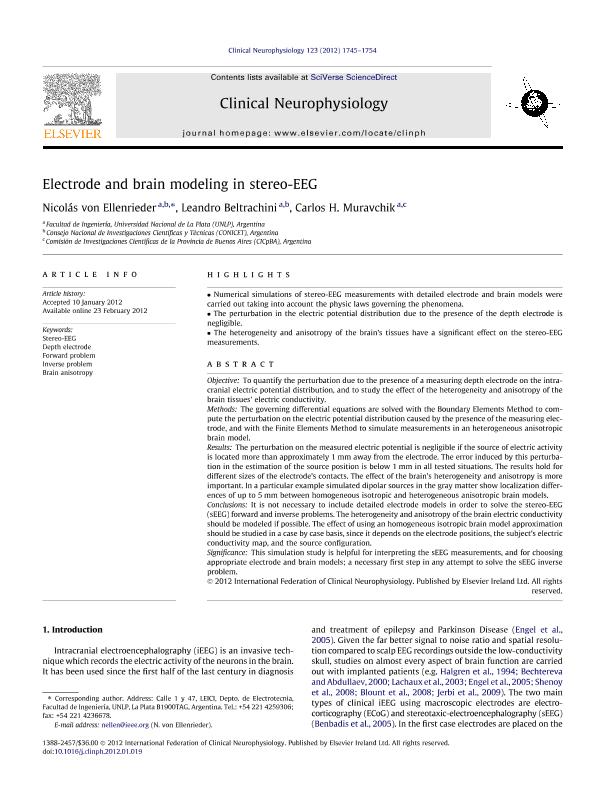Mostrar el registro sencillo del ítem
dc.contributor.author
Von Ellenrieder, Nicolás

dc.contributor.author
Beltrachini, Leandro

dc.contributor.author
Muravchik, Carlos Horacio

dc.date.available
2023-03-17T11:26:45Z
dc.date.issued
2012-09
dc.identifier.citation
Von Ellenrieder, Nicolás; Beltrachini, Leandro; Muravchik, Carlos Horacio; Electrode and brain modeling in stereo-EEG; Elsevier Ireland; Clinical Neurophysiology; 123; 9; 9-2012; 1745-1754
dc.identifier.issn
1388-2457
dc.identifier.uri
http://hdl.handle.net/11336/190869
dc.description.abstract
Objective: To quantify the perturbation due to the presence of a measuring depth electrode on the intracranial electric potential distribution, and to study the effect of the heterogeneity and anisotropy of the brain tissues' electric conductivity. Methods: The governing differential equations are solved with the Boundary Elements Method to compute the perturbation on the electric potential distribution caused by the presence of the measuring electrode, and with the Finite Elements Method to simulate measurements in an heterogeneous anisotropic brain model. Results: The perturbation on the measured electric potential is negligible if the source of electric activity is located more than approximately 1. mm away from the electrode. The error induced by this perturbation in the estimation of the source position is below 1. mm in all tested situations. The results hold for different sizes of the electrode's contacts. The effect of the brain's heterogeneity and anisotropy is more important. In a particular example simulated dipolar sources in the gray matter show localization differences of up to 5. mm between homogeneous isotropic and heterogeneous anisotropic brain models. Conclusions: It is not necessary to include detailed electrode models in order to solve the stereo-EEG (sEEG) forward and inverse problems. The heterogeneity and anisotropy of the brain electric conductivity should be modeled if possible. The effect of using an homogeneous isotropic brain model approximation should be studied in a case by case basis, since it depends on the electrode positions, the subject's electric conductivity map, and the source configuration. Significance: This simulation study is helpful for interpreting the sEEG measurements, and for choosing appropriate electrode and brain models; a necessary first step in any attempt to solve the sEEG inverse problem. © 2012 International Federation of Clinical Neurophysiology.
dc.format
application/pdf
dc.language.iso
eng
dc.publisher
Elsevier Ireland

dc.rights
info:eu-repo/semantics/openAccess
dc.rights.uri
https://creativecommons.org/licenses/by-nc-sa/2.5/ar/
dc.subject
BRAIN ANISOTROPY
dc.subject
DEPTH ELECTRODE
dc.subject
FORWARD PROBLEM
dc.subject
INVERSE PROBLEM
dc.subject
STEREO-EEG
dc.subject.classification
Ingeniería Eléctrica y Electrónica

dc.subject.classification
Ingeniería Eléctrica, Ingeniería Electrónica e Ingeniería de la Información

dc.subject.classification
INGENIERÍAS Y TECNOLOGÍAS

dc.title
Electrode and brain modeling in stereo-EEG
dc.type
info:eu-repo/semantics/article
dc.type
info:ar-repo/semantics/artículo
dc.type
info:eu-repo/semantics/publishedVersion
dc.date.updated
2023-03-05T15:35:36Z
dc.journal.volume
123
dc.journal.number
9
dc.journal.pagination
1745-1754
dc.journal.pais
Irlanda

dc.journal.ciudad
https://ri.conicet.gov.ar/admin/static/images/left.png
dc.description.fil
Fil: Von Ellenrieder, Nicolás. Universidad Nacional de La Plata. Facultad de Ingeniería. Departamento de Electrotecnia. Laboratorio de Electrónica Industrial, Control e Instrumentación; Argentina. Consejo Nacional de Investigaciones Científicas y Técnicas. Centro Científico Tecnológico Conicet - La Plata; Argentina
dc.description.fil
Fil: Beltrachini, Leandro. Universidad Nacional de La Plata. Facultad de Ingeniería. Departamento de Electrotecnia. Laboratorio de Electrónica Industrial, Control e Instrumentación; Argentina. Consejo Nacional de Investigaciones Científicas y Técnicas. Centro Científico Tecnológico Conicet - La Plata; Argentina
dc.description.fil
Fil: Muravchik, Carlos Horacio. Universidad Nacional de La Plata; Argentina. Provincia de Buenos Aires. Gobernación. Comisión de Investigaciones Científicas; Argentina
dc.journal.title
Clinical Neurophysiology

dc.relation.alternativeid
info:eu-repo/semantics/altIdentifier/doi/http://dx.doi.org/10.1016/j.clinph.2012.01.019
dc.relation.alternativeid
info:eu-repo/semantics/altIdentifier/url/https://www.sciencedirect.com/science/article/abs/pii/S1388245712000673
Archivos asociados
